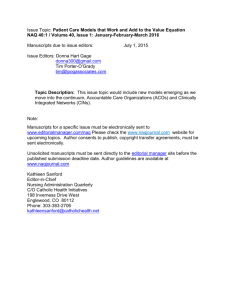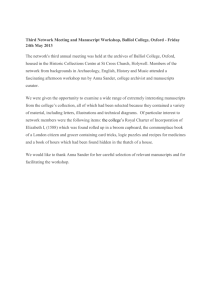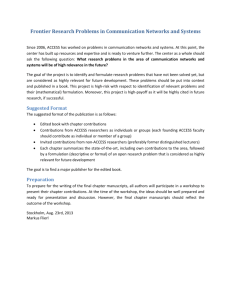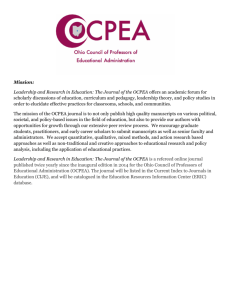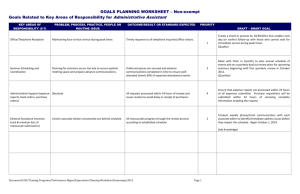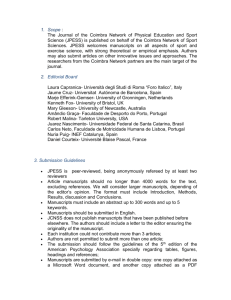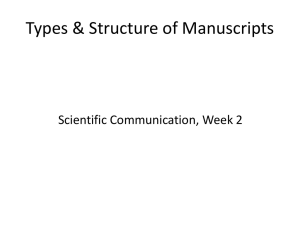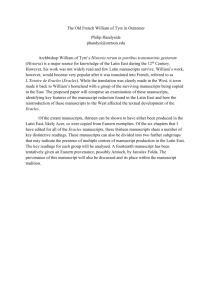The New Testament Writings (Books & Manuscripts) (Int NT, chap 2
advertisement
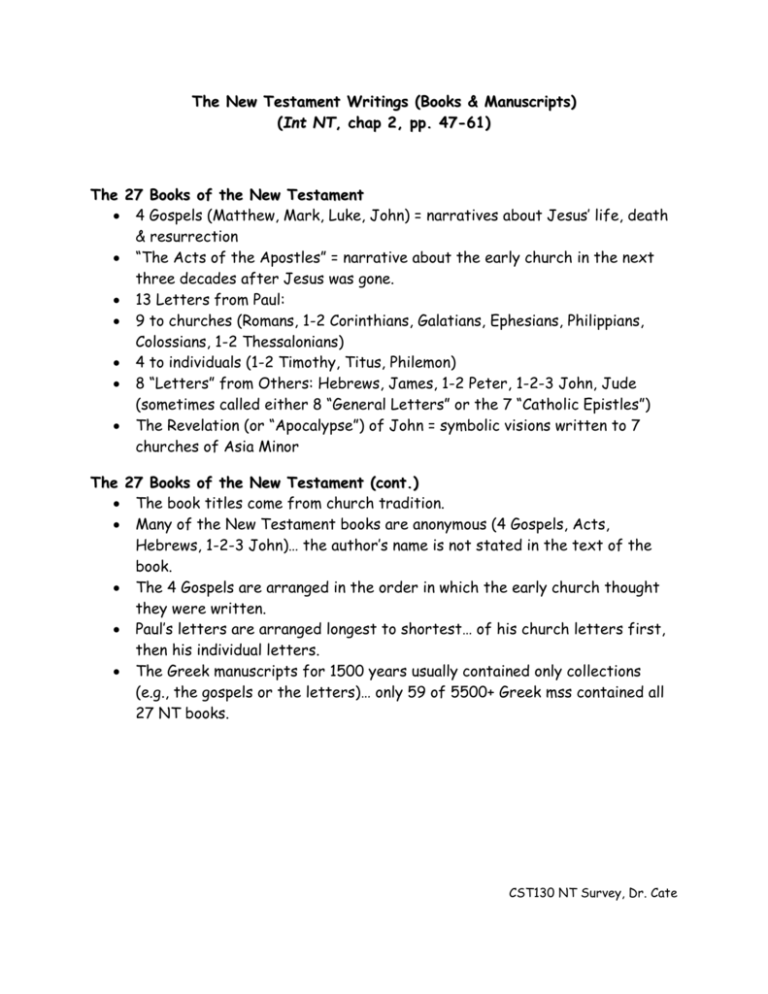
The New Testament Writings (Books & Manuscripts) (Int NT, chap 2, pp. 47-61) The 27 Books of the New Testament 4 Gospels (Matthew, Mark, Luke, John) = narratives about Jesus’ life, death & resurrection “The Acts of the Apostles” = narrative about the early church in the next three decades after Jesus was gone. 13 Letters from Paul: 9 to churches (Romans, 1-2 Corinthians, Galatians, Ephesians, Philippians, Colossians, 1-2 Thessalonians) 4 to individuals (1-2 Timothy, Titus, Philemon) 8 “Letters” from Others: Hebrews, James, 1-2 Peter, 1-2-3 John, Jude (sometimes called either 8 “General Letters” or the 7 “Catholic Epistles”) The Revelation (or “Apocalypse”) of John = symbolic visions written to 7 churches of Asia Minor The 27 Books of the New Testament (cont.) The book titles come from church tradition. Many of the New Testament books are anonymous (4 Gospels, Acts, Hebrews, 1-2-3 John)… the author’s name is not stated in the text of the book. The 4 Gospels are arranged in the order in which the early church thought they were written. Paul’s letters are arranged longest to shortest… of his church letters first, then his individual letters. The Greek manuscripts for 1500 years usually contained only collections (e.g., the gospels or the letters)… only 59 of 5500+ Greek mss contained all 27 NT books. CST130 NT Survey, Dr. Cate NT Canon: Who Chose These Books? The Bible of the earliest Christians was the Greek OT (Septuagint or “LXX”). The Gospels as a collection in the Second Century: Matthew, Mark, Luke, & John were written in the first century. Marcion (an influential heretic, ~AD 140s) rejected the OT and all things Jewish… and only used an edited version of Luke. Cerinthus and the Ebionites only used Matthew. The Gospel of John was also a favorite among the Gnostics. Mark was greatly neglected. Gnostics wrote and used many apocryphal gospels. Tatian harmonized Mt-Mk-Lk-Jn into his “Diatessaron” (~AD 170) Irenaeus (~AD 180) declared there were 4 and only 4 Gospels… no more (cf. the Gnostics)… and no less (cf. Marcion, the Ebionites, etc.) Paul’s letters as a collection: Acts never mentions Paul’s letters. 2 Pet 3:15-16, “…just as our beloved brother Paul also wrote to you according to the wisdom given him, 16 as he does in all his letters when he speaks in them of these matters. There are some things in them that are hard to understand, which the ignorant and unstable twist to their own destruction, as they do the other Scriptures.” Marcion esteemed 10 letters of Paul as scripture. P46 (~200 AD) is the earliest extant collection of Paul’s letters (Rom, Heb, 1-2 Cor, Gal, Eph, Php, Col, 1-2 Thess) Other books in the second and third centuries: Acts, 1 Peter, and 1 John were widely used & accepted. Hebrews was debated because it’s anonymous. James was used in the east, but not the west. 2 Peter was uncertain because of authorship issues. 2 John, 3 John, & Jude didn’t circulate well because they are so short. Revelation was used by some & not by others because the symbolism makes it difficult to understand. Occasionally, other bks (e.g., Shepherd of Hermas, Epistle of Barnabas, 1-2 Clement, etc.) were used as scripture… but eventually rejected because they’re too late (2nd cent.) & had no apostolic connection. In 367 AD, Athanasius listed the 27 NT books. The copying of manuscripts standardized the 27 books as the NT canon. CST130 NT Survey, Dr. Cate NT Text: How Were These Books Copied? No original copy of any NT book exists, nor any manuscript from the first century. 5500+ manuscripts in Greek exist… but these manuscripts occasionally differ slightly in wording. Generally, the most important Greek mss are the earliest ones, closest to the time of writing. The manuscripts had no chapter or verse divisions… those were added later (chapters in 1200s, verses in 1550s). The early manuscripts had no word breaks or punctuation. Early Christians used the “codex” (= book with pages) for mss, and only rarely a roll (or scroll). Four Kinds of NT Greek Manuscripts: Type: Characteristics: Number extant: Examples: Papyrus Manuscripts papyrus, fragmentary, first five centuries 125 extant today 𝔓45, 𝔓46, 𝔓47 𝔓52, 𝔓72, 𝔓75 Uncial Manuscripts all capital letters, parchment, 4th century & later 280 extant today a, A, B, C, D Minuscule Manuscripts cursive writing inferior as witnesses 9th century & later ~2,800 extant today 33, 1739 Greek Lectionaries non-continuous text, collections of passages for readings in worship ~2,300 extant today l211, l184 Distribution of Greek Manuscripts: Few in the early centuries. Hundreds & hundreds minuscule from the 11th to 14th centuries. CST130 NT Survey, Dr. Cate Example of a Textual Variant: Matthew 6:9b-13 according to Various Manuscripts and Textual Witnesses 9b Our Father in heaven, hallowed be your 9b Our Father in heaven, hallowed be your name. 10 Your kingdom come, your will be name. 10 Your kingdom come, your will be done, on earth as it is in heaven. 11 Give us this done, on earth as it is in heaven. 11 Give us this day our daily bread, 12 and forgive us our day our daily bread, 12 and forgive us our debts, as we also have forgiven our debtors. 13 debts, as we also have forgiven our debtors. 13 And lead us not into temptation, but deliver us And lead us not into temptation, but deliver us from evil. from evil. For yours is the kingdom and the power and the glory, forever. Amen. Supported by the Witnesses: a B D Z 0170 f a, aur, b, c, ff1, h, l (17) 205 l547 it bo-pt cl 1 meg, vg (vg ) cop syr dub Diatessaron Origen Cyril-Jerusalem Gregory-Nyssa Cyril Tertullian Cyprian Ambrosiaster Ambrose Chromatius Jerome Augustine Supported by the Witnesses: L W D Q 0233 f 28 33 (157) 180 565 579 597 700 892 1006 13 c 1010 1071 1241 1243 (1253) 1292 (1342) (syr ) f, (g-1 q k) 1424 1505 Byz Lect it h, p, pal syr bo-pt, cop (sa, fay) (Didache) arm eth geo slav Larger Variants in the NT: Mark 16:9-20 (The Ending of Mark) No ending after 16:8? (most likely the earliest reading) The shorter ending? (probably added later) The longer ending (16:9-20)? (probably added later) John 7:53-8:11 (The Story of the Adulteress) Omitted in earliest mss Other mss include the passage at 6 different locations (after Jn 7:36; 7:44; 7:52; 21:25; Lk 21:38; Lk 24:53) Most later mss include the episode after Jn 7:52 1 John 5:7b-8a (The Johannine Comma) Unknown in Greek prior to the 16th century Known and used in the Latin Vulgate Ended up included in Erasmus’ Greek NT (3rd ed) and KJV CST130 NT Survey, Dr. Cate Examples of mss of other ancient literature: The Gallic War by Julius Caesar (ca. 58-50 BC) Only ten good manuscripts exist. The oldest manuscript is from the ninth century. The Roman History by Livy (ca. 59 BC-AD 17) Only 35 of 142 books survive. Only 20 manuscripts exist. The oldest manuscript fragment is from the fourth century. The Histories by Tacitus (ca. AD 100) Only 4.5 of 14 books survive. The Annals of Tacitus (ca. AD 100) Only 10 of 16 books survive in full and 2 in part. Only 2 manuscripts exist, one from the ninth century, the other from the eleventh. The History of the Peloponnesian War by Thucydides (ca. 460-400 BC). Only 8 manuscripts survive. The oldest existing manuscript is from the tenth century. The History of Herodotus (ca. 488-428 BC). Only a few manuscripts survive, the oldest of which is from the ninth century AD. The New Testament. 5,567 manuscripts exist in Greek (and 8000 more in Latin). A hundred of the manuscripts are from the fifth century or earlier. CST130 NT Survey, Dr. Cate

